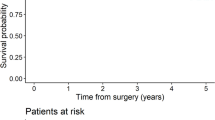Abstract
Minimally invasive mitral valve repair, recently, has become an alternative procedure to conventional mitral valve surgery, given its clinical benefits. Understanding the learning curve of a new procedure is important prior to its introduction. This study aimed to evaluate the learning curve for minimally invasive mitral valve repair and safety during the start-up period. The first 100 consecutive patients who underwent isolated minimally invasive mitral valve repair for mitral valve regurgitation were evaluated. The procedure was performed by a single surgeon at a single institution. Calculated cumulative sum analysis and cubic spline curve analysis were performed to evaluate the learning curves for the total procedure (TP), extracorporeal circulation (ECC), and aortic cross-clamping (ACC) times. ACC time was affected by the complexity of individual mitral valve repair; therefore, we analyzed the TP minus ACC (TP-ACC) time as a true learning curve by subtracting the ACC time from the TP time to exclude the difference of the complexity. Additionally, the operative outcome was assessed. Overall, the average TP, ECC, ACC, TP-ACC times were 211 ± 41, 133 ± 35, 108 ± 31, and 104 ± 4.9 min, respectively. All cubic spline curves depicted a decreasing trend, and improvements in TP, ECC, and ACC times were observed after 56 cases, while those of the TP-ACC time were observed after 68 cases. None of the patients experienced hospital mortality, reoperation for bleeding, respiratory failure, cerebral infarction with a disability, or recurrence of mitral valve regurgitation. Acute renal failure occurred in one patient. In conclusion, minimally invasive mitral valve repair can be introduced safely and provide a favorable outcome. However, a learning curve exists for the operative time factors. Approximately 60 operations are required to achieve a consistent operative time.


Similar content being viewed by others
References
Walther T, Falk V, Metz S, Diegeler A, Battellini R, Autschbach R, Mohr FW (1999) Pain and quality of life after minimally invasive versus conventional cardiac surgery. Ann Thorac Surg 67:1643–1647
Modi P, Hassan A, Chitwood WR Jr (2008) Minimally invasive mitral valve surgery: a systematic review and meta-analysis. Eur J Cardiothorac Surg 34:943–952
Raanani E, Spiegelstein D, Sternik L, Preisman S, Moshkovitz Y, Smolinsky AK, Shinfeld A (2010) Quality of mitral valve repair: median sternotomy versus port-access approach. J Thorac Cardiovasc Surg 140:86–90
Nakamura Y, Noshijima S, Kuroda M, Nakayama T, Tsuruta R, Yoshiyama D, Yasumoto Y, Ito Y (2021) Perfusion Strategy using axillary or femoral cannulation for minimally invasive cardiac surgery: experience in 270 patients with computed tomography-based criteria. Eur J Cardiothorac Surg. https://doi.org/10.1093/ejcts/ezaa469
de Leval MR, Francois K, Bull C, Brawn W, Spiegelhalter D (1994) Analysis of a cluster of surgical failures. Application to a series of neonatal arterial switch operations. J Thorac Cardiovasc Surg 107:914–923
Rogers CA, Reeves BC, Caputo M, Ganesh JS, Bonser RS, Angelini GD (2004) Control chart methods for monitoring cardiac surgical performance and their interpretation. J Thorac Cardiovasc Surg 128:811–819
Holzhey DM, Seeburger J, Misfeld M, Borger MA, Mohr FW (2013) Learning minimally invasive mitral valve surgery: a cumulative sum sequential probability analysis of 3895 operations from a single high-volume center. Circulation 128:483–491
De Praetere H, Verbrugghe P, Rega F, Meuris B, Herijgers P (2015) Starting minimally invasive valve surgery using endoclamp technology: safety and results of a starting surgeon. Interact Cardiovasc Thorac Surg 20:351–358
Ramsay CR, Grant AM, Wallace SA, Garthwaite PH, Monk AF, Russell IT (2000) Assessment of the learning curve in health technologies. A systematic review. Int J Technol Assess Health Care 16:1095–1108
Committee for Scientific Affairs, The Japanese Association for Thoracic Surgery, Masuda M, Okumura M, Doki Y, Endo S, Hirata Y, Kobayashi J, Kuwano H, Motomura N, Nishida H, Saiki Y, Saito A, Shimizu H, Tanaka F, Tanemoto K, Toh Y, Tsukihara H, Wakui S, Yokomise H (2016) Thoracic and cardiovascular surgery in Japan during 2014: annual report by The Japanese Association for Thoracic Surgery. Gen Thorac Cardiovasc Surg 64:665–697
Svensson LG, Atik FA, Cosgrove DM, Blackstone EH, Rajeswaran J, Krishnaswamy G, Jin U, Gillinov AM, Griffin B, Navia JL, Mihaljevic T, Lytle BW (2010) Minimally invasive versus conventional mitral valve surgery: a propensity-matched comparison. J Thorac Cardiovasc Surg 139:926-932.e1–2
Castillo JG, Anyanwu AC, Fuster V, Adams DH (2012) A near 100% repair rate for mitral valve prolapse is achievable in a reference center: implications for future guidelines. J Thorac Cardiovasc Surg 144:308–312
Acknowledgements
We thank Dr. Watanabe for his helpful advice on the statistical methods. We would like to thank Editage (https://www.editage.com) for English language editing.
Funding
None.
Author information
Authors and Affiliations
Contributions
All authors contributed to the study conception and design. Material preparation, data collection, and analysis were performed by YH, TH, and YI. The first draft of the manuscript was written by YH, and all authors commented on the previous versions of the manuscript. All authors have read and approved the final manuscript.
Corresponding author
Ethics declarations
Conflict of interest
The authors declare that they have no conflicts of interest.
Informed consent
Informed consent was obtained from all individual participants included in the study.
Additional information
Publisher's Note
Springer Nature remains neutral with regard to jurisdictional claims in published maps and institutional affiliations.
Rights and permissions
About this article
Cite this article
Hayashi, Y., Nakamura, Y., Hirano, T. et al. Cumulative sum analysis for the learning curve of minimally invasive mitral valve repair. Heart Vessels 36, 1584–1590 (2021). https://doi.org/10.1007/s00380-021-01838-7
Received:
Accepted:
Published:
Issue Date:
DOI: https://doi.org/10.1007/s00380-021-01838-7




